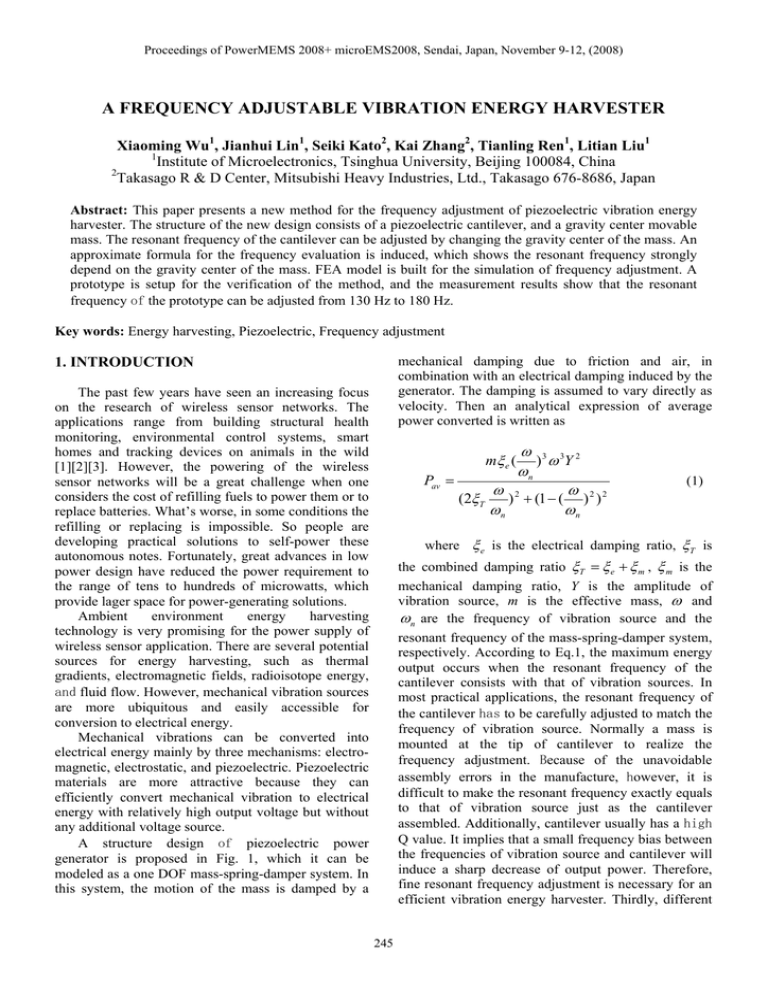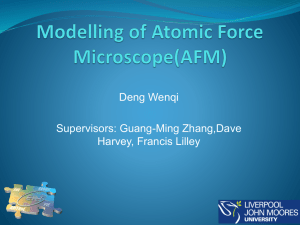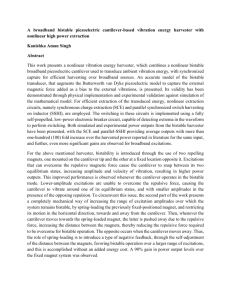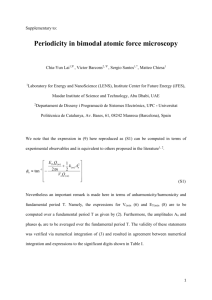A FREQUENCY ADJUSTABLE VIBRATION ENERGY HARVESTER
advertisement

Proceedings of PowerMEMS 2008+ microEMS2008, Sendai, Japan, November 9-12, (2008) A FREQUENCY ADJUSTABLE VIBRATION ENERGY HARVESTER Xiaoming Wu1, Jianhui Lin1, Seiki Kato2, Kai Zhang2, Tianling Ren1, Litian Liu1 1 Institute of Microelectronics, Tsinghua University, Beijing 100084, China 2 Takasago R & D Center, Mitsubishi Heavy Industries, Ltd., Takasago 676-8686, Japan Abstract: This paper presents a new method for the frequency adjustment of piezoelectric vibration energy harvester. The structure of the new design consists of a piezoelectric cantilever, and a gravity center movable mass. The resonant frequency of the cantilever can be adjusted by changing the gravity center of the mass. An approximate formula for the frequency evaluation is induced, which shows the resonant frequency strongly depend on the gravity center of the mass. FEA model is built for the simulation of frequency adjustment. A prototype is setup for the verification of the method, and the measurement results show that the resonant frequency of the prototype can be adjusted from 130 Hz to 180 Hz. Key words: Energy harvesting, Piezoelectric, Frequency adjustment mechanical damping due to friction and air, in combination with an electrical damping induced by the generator. The damping is assumed to vary directly as velocity. Then an analytical expression of average power converted is written as 1. INTRODUCTION The past few years have seen an increasing focus on the research of wireless sensor networks. The applications range from building structural health monitoring, environmental control systems, smart homes and tracking devices on animals in the wild [1][2][3]. However, the powering of the wireless sensor networks will be a great challenge when one considers the cost of refilling fuels to power them or to replace batteries. What’s worse, in some conditions the refilling or replacing is impossible. So people are developing practical solutions to self-power these autonomous notes. Fortunately, great advances in low power design have reduced the power requirement to the range of tens to hundreds of microwatts, which provide lager space for power-generating solutions. Ambient environment energy harvesting technology is very promising for the power supply of wireless sensor application. There are several potential sources for energy harvesting, such as thermal gradients, electromagnetic fields, radioisotope energy, and fluid flow. However, mechanical vibration sources are more ubiquitous and easily accessible for conversion to electrical energy. Mechanical vibrations can be converted into electrical energy mainly by three mechanisms: electromagnetic, electrostatic, and piezoelectric. Piezoelectric materials are more attractive because they can efficiently convert mechanical vibration to electrical energy with relatively high output voltage but without any additional voltage source. A structure design of piezoelectric power generator is proposed in Fig. 1, which it can be modeled as a one DOF mass-spring-damper system. In this system, the motion of the mass is damped by a ω 3 3 2 ) ωY ωn Pav = ω 2 ω (2ξ T ) + (1 − ( ) 2 ) 2 ωn ωn mξ e ( (1) where ξ e is the electrical damping ratio, ξ T is the combined damping ratio ξ T = ξ e + ξ m , ξ m is the mechanical damping ratio, Y is the amplitude of vibration source, m is the effective mass, ω and ωn are the frequency of vibration source and the resonant frequency of the mass-spring-damper system, respectively. According to Eq.1, the maximum energy output occurs when the resonant frequency of the cantilever consists with that of vibration sources. In most practical applications, the resonant frequency of the cantilever has to be carefully adjusted to match the frequency of vibration source. Normally a mass is mounted at the tip of cantilever to realize the frequency adjustment. Because of the unavoidable assembly errors in the manufacture, however, it is difficult to make the resonant frequency exactly equals to that of vibration source just as the cantilever assembled. Additionally, cantilever usually has a high Q value. It implies that a small frequency bias between the frequencies of vibration source and cantilever will induce a sharp decrease of output power. Therefore, fine resonant frequency adjustment is necessary for an efficient vibration energy harvester. Thirdly, different 245 Proceedings of PowerMEMS 2008+ microEMS2008, Sendai, Japan, November 9-12, (2008) vibration sources normally have different vibration characteristics, such as frequency spectrum and vibration level. Therefore, a large frequency adjustment range of piezoelectric cantilever will benefit the wide applications of vibration energy harvester. The proof mass consists of two parts, a fixed one with mass of m0 and a movable one with mass of m1. The mass of piezoelectric element can be taken into account as partial fixed mass. Therefore, the total proof mass is the sum of the two parts, that is M = m0 + m1 The position of movable part can be moved along the lognitudinal direction of the piezoelectric element. Then the gravity center of the whole proof mass is changed. As shown in Fig.2, parameters l0, l1, and l are used to describe the position of the gravity centers of the fixed part, movable part, and the whole proof mass respectively. Then, the gravity center of the whole proof mass is, Fig.1 Schematic of piezoelectric cantilever with proof mass 2. THEORY OF RESONANT FREQUENCY ADJUSTMENT l= Simplified as a mass-spring-damper system, the resonant frequency of cantilever with a mass at tip is described as, ω= k m (3) m0l0 + m1l1 M (4) The deflection of the cantilever under vibration stimulation is very nearly that of a massless beam with a rigid distributed mass M at its end. For a static load Fy acting on the centroid of M, the deflection of cantilever can be written as (2) ⎧ Fy x 2 ⎛ x ⎞ 0≤ x≤ L ⎜L− +l⎟ ⎪ 3 ⎠ ⎪ 2 EI z ⎝ y=⎨ 2 2 ⎪ Fy L ⎛ 2 L + l ⎞ + ⎛⎜ Fy L + Fy lL ⎞⎟( x − L ) ⎟ ⎜ ⎪ 2 EI ⎝ 3 ⎠ ⎜⎝ 2 EI z EI z ⎟⎠ z ⎩ L < x ≤ L + 2l Where, m is the sum of mass and the effective mass of cantilever, k is the spring constant of cantilever. To adjust the resonant frequency of cantilever, a new proof mass is designed whose gravity center is movable. If the gravity center of the mass is changed, one more torque is acted on the cantilever compared to the original system. Then, the effective spring constant of the whole system is changed, and the resonant frequency will be also adjusted. Fig. 2 shows the schematic of the new structure. (5) where, E and L are Young’s Module and length of the bent part of the cantilever respectively, which contributes to the function of spring in the system. Note that the restoring force (Fy) on the mass M is proportional to its displacement, giving simple harmonic motion. Normally the vibration energy harvesting has a high Q value. It implies that very small energy is transferred into output electric energy and heat dissipation, which are described as electric and mechanical damping ratio respectively. For the convenience of resonant frequency evaluation, both mechanical and electric energy dissipations are neglected. The mass-spring-damper system is assumed to obey the conservation of energy law. Applying the Rayleigh principle to the deflection curve of cantilever, a good approximation to the resonant frequency ωn is obtained[4][5] (for M uniformly distributed) Fig. 2 Schematic of the piezoelectric element with gravity center movable mass 246 Proceedings of PowerMEMS 2008+ microEMS2008, Sendai, Japan, November 9-12, (2008) ωn ≈ EI z ML3 6f 2 +6f +2 8 f 4 + 14 f 3 + 10.5 f 2 + 4 f + 2 3 mounted side of cantilever. The cause of the errors is the rotation energy of the proof mass becomes larger in this case. However, it is always neglected during the induction of the approximate formula. Because more kinetic energy is assumed to be stored in the cantilever, the resonant frequency is overestimated in the approximate formula calculation. (6) where, f = l L , Iz is moment of inertia of the cantilever. For the beams with rectangular crosssection, the moment of inertia can be calculated by 1 3 db , where b and d are the width and 12 Iz = thickness of the beam respectively. When l=0, the above equation is reduced to ω0 ≈ 3EI z , which is the typical formula for a ML3 cantilever with rigid distributed mass at the end. Normalized ωn to ω0, one can obtain an approximate resonant frequency change which depends on the gravity center of the proof mass. ω= ωn 1 6f 2 +6f +2 ≈ 2 ω0 3 4 8 f + 14 f 3 + 10.5 f 2 + 4 f + (7) Fig. 3 Model structure for FEA simulation 3 3. FINITE ELEMENT ANALYSIS (FEA) FOR THE FREQUENCY ADJUSTMENT To verify the abovementioned theory of resonant frequency adjustment, a simple model is built using an universal FEA software (ANSYS®) and numerical simulation is carried out for modal analysis. The structure of the model, shown in Fig.3, is simplified for the convenience of model building and numerical calculation. The movable part of mass is cubical, but not cylindrical as shown in Fig.2 and practical experiment prototype. The material characteristics of the movable and fixed parts of the mass are assumed the same. According to Eq. 6, the nature of the frequency adjustment theory is changing the gravity center of the mass. Therefore, the shape and material characteristics of the mass are not the key points. A valuable result can also be obtained using the simplified model. The FEA simulation result of the simplified structure model is shown in Fig.4. The data are also normalized. The theoretical analysis result obtained by Eq. (7) is also plotted on the same figure. The two curves show the same trend in the range that we are interested in. There are errors between the results of approximate formula and FEA analysis, especially when the normalized gravity center of mass is negative. In other words, the gravity center moves to the Fig.4 Gravity center of proof mass dependence of the resonant frequency of cantilever, by FEA simulation and approximate formula (the frequency is normalized to the value when the gravity center of proof mass is just at the tip of the bent part of cantilever, the position change of the gravity center of mass is normalized to the length of the bent part of cantilever) 4. EXPERIMENT RESULTS Based on the theory discussed in section 2, an energy harvester prototype with gravity center movable mass is developed and tested. The picture of the prototype with piezoelectric cantilever is shown in Fig.5. The proof mass consists of a fixed part and a 247 Proceedings of PowerMEMS 2008+ microEMS2008, Sendai, Japan, November 9-12, (2008) movable part. In order to enlarge the moving distance of the gravity center of the whole proof mass, the fixed part of mass is made of the material with relative small density (eg. aluminum) and the movable part material is with large density (eg. steel). Screw threads are cut on both the outer surface of the cylinder movable part and the inner surface of the hole on the fixed part. Then the movable part mass can be driven in and out the fixed mass through the thread fitting. The thread fitting is also helpful to fix the relative position of the movable part mass. Another stud is used to fasten the movable part to avoid its moving during the vibration. The fixed part mass is made of aluminum, and with size of 10×12×38 mm3. The steel movable part mass is with radius of 6 mm, and length of 30 mm. Fig.7 shows the output voltage of the piezoelectric energy harvester prototype at different frequencies. Fig.7 Frequency dependence of output voltage for piezoelectric energy harvester prototype Fixed part of mass 5. CONCLUSION Movable part of mass This paper presents a new method for the resonant frequency adjustment of piezoelectric vibration energy harvester. An approximate formula for the fine adjustment of the resonant frequency is induced. A prototype of the frequency adjustable piezoelectric cantilever is developed and tested. The test results show that the frequency of the prototype covers 130 Hz to 180 Hz. Piezo element Fastening stud REFERENCES Fig.5 Picture of the piezoelectric cantilever prototype with gravity center movable mass [1] Shad Roundy, Paul K. Wright, and Jan Rabaey 2003 A study of low level vibrations as a power source for wireless sensor nodes, Computer Communications, 26(11), 1131-1144 [2] Y C Shu1 and I C Lien 2006 Analysis of power output for piezoelectric energy harvesting systems, Smart Materials and Structures, 15 1499–1512 [3] S. Roundy, P. K. Wright, and J. Rabaey, 2003 Energy scavenging for wireless sensor networks with special focus on vibrations (Kluwer Academic Press) [4] W. T. Thomson 1992 Theory of vibration with applications (Prentice-Hall, Englewood Cliffs, NJ) [5] L. Roylance, J. B. Angell 1979 A batch fabricated silicon accelerometer, IEEE Transactions on Electron Devices, 26(12) 1911-1917 Fig.6 shows the adjusted resonant frequency range of the prototype, which is from 130 Hz to 180 Hz. This range covers lots of mechanical vibration sources in ambient environment. Fig.6 Experiment result of frequency adjustment (The length of the movable part mass is 30mm) 248





